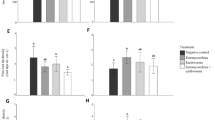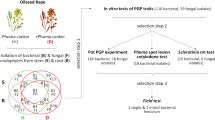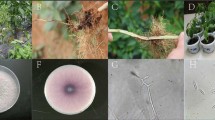Abstract
USING nematological methods of wet sieving and decanting with agricultural soils in Illinois, Gerdemann1,2 extracted two types of large one-celled spores which gave endotrophic mycorrhiza of the phycornycetous type in inoculated plants. The larger of these spores, 183–812µ diam., produced arbuscules but not vesicles in infected roots. Clusters of echinulate one-celled spores were formed on external hyphæ1. A smaller spore, 133–288µ diam., induced typical vesicular-arbuscular infections and, in addition, produced on hyphæ surrounding the roots an Endogone sporocarpic stage and chlamydospores2. The chlamydospores were identical with those extracted from field soil and the sporocarps were similar to those produced by the unnamed mycorrhizal species of Endogone described by Mosse3.
This is a preview of subscription content, access via your institution
Access options
Subscribe to this journal
Receive 51 print issues and online access
$199.00 per year
only $3.90 per issue
Buy this article
- Purchase on Springer Link
- Instant access to full article PDF
Prices may be subject to local taxes which are calculated during checkout
Similar content being viewed by others
References
Gerdemann, J. W., Mycologia, 47, 619 (1955).
Gerdemann, J. W., Mycologia, 53, 254 (1961).
Mosse, B., Ann. Bot., 20, 349 (1956).
Author information
Authors and Affiliations
Rights and permissions
About this article
Cite this article
GERDEMANN, J., NICOLSON, T. Endogone Spores in Cultivated Soils. Nature 195, 308–309 (1962). https://doi.org/10.1038/195308b0
Issue Date:
DOI: https://doi.org/10.1038/195308b0
This article is cited by
-
Rhizoglomus melanum, a new arbuscular mycorrhizal fungal species associated with submerged plants in freshwater lake Avsjøen in Norway
Mycological Progress (2015)
-
Nickel tolerance of serpentine and non-serpentine Knautia arvensis plants as affected by arbuscular mycorrhizal symbiosis
Mycorrhiza (2014)
-
Soil nutritional status, not inoculum identity, primarily determines the effect of arbuscular mycorrhizal fungi on the growth of Knautia arvensis plants
Mycorrhiza (2013)
-
Arbuscular mycorrhizal symbiosis alleviates drought stress imposed on Knautia arvensis plants in serpentine soil
Plant and Soil (2013)
-
A history of research on arbuscular mycorrhiza
Mycorrhiza (2004)
Comments
By submitting a comment you agree to abide by our Terms and Community Guidelines. If you find something abusive or that does not comply with our terms or guidelines please flag it as inappropriate.



